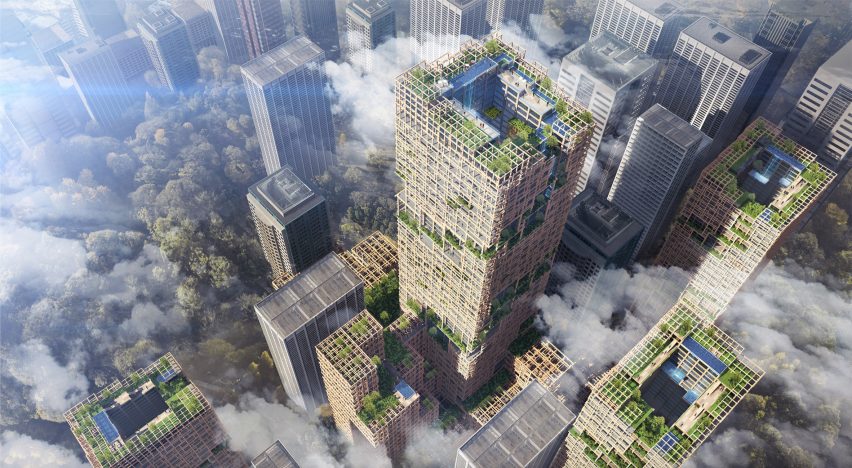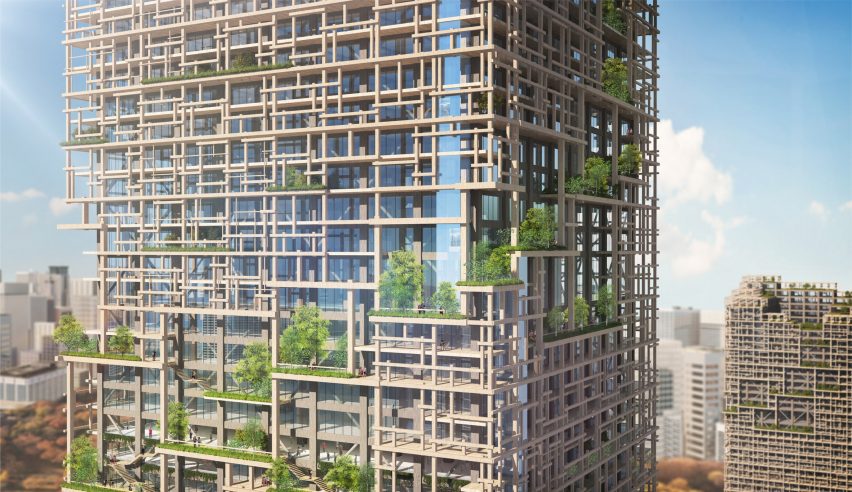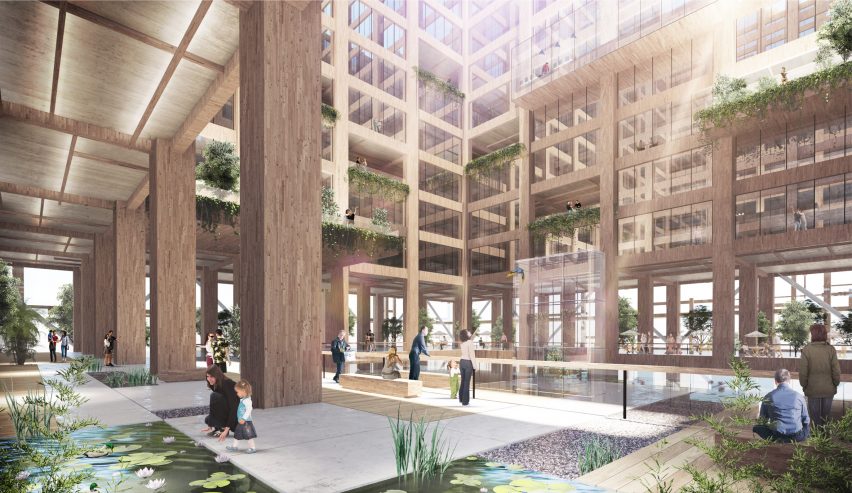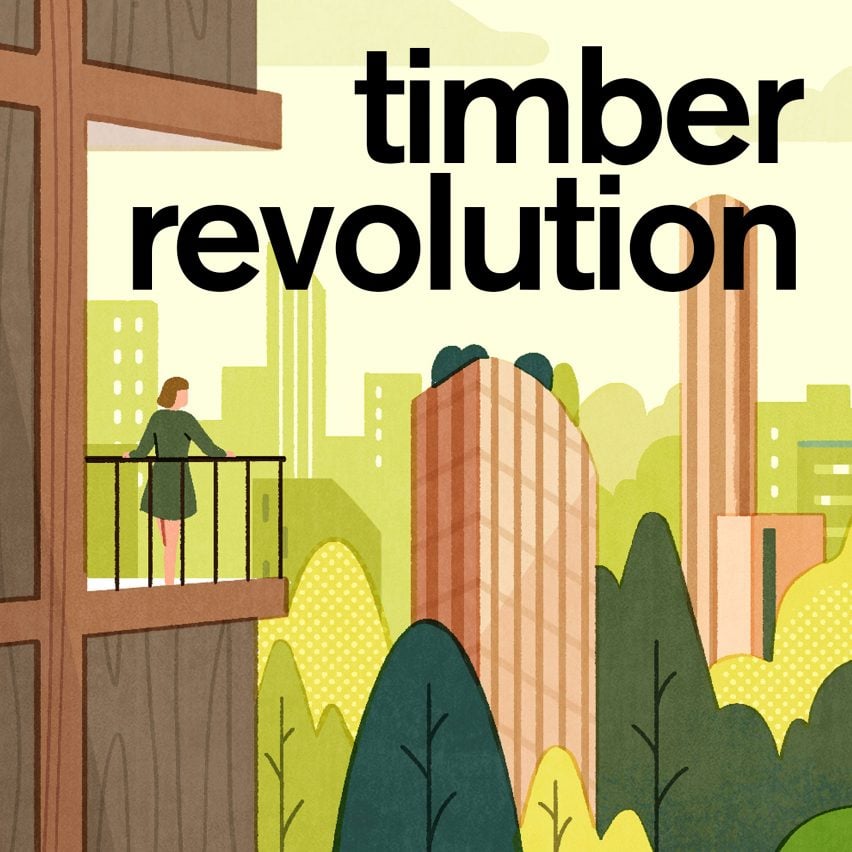
"Promote demand for wood in low-rise buildings" says architect of timber supertall concept
Ambitious concepts like Nikken Sekkei's proposal for the world's tallest timber skyscraper can accelerate the use of engineered wood but should not be the focus, argues Hajime Aoyagi in this Timber Revolution interview.
Aoyagi is part of a team at Japanese studio Nikken Sekkei that is working on the W350 Plan – a joint research project with wood manufacturer Sumitomo Forestry centred on a concept for the world's tallest wooden building in Tokyo.
The proposed tower would be 350 metres tall – around four times higher than the current tallest mass-timber building, Ascent Tower in the US and past the threshold to be considered a supertall skyscraper.

"It is not intended for immediate construction at this point in time, but by setting major goals, it aims to create a roadmap for technological development and uncover issues that need to be solved [in mass timber]," explained Aoyagi.
"Another objective is to raise awareness of the general public by asking why we need to use timber at all," he continued.
Despite the interest attracted by Sumitomo Forestry's and Nikken Sekkei's vision to reach record-breaking heights, Aoyagi believes this is not the most important aspect of the project.
"We should promote demand for wood in low-rise buildings"
For him, the true value of the concept lies in sparking interest in mass timber and encouraging its uptake in architecture – particularly in Japan.
"We do not think it is necessary to focus too much on high-rise buildings or pure mass-timber construction," he explained.
"If it is effective for that purpose, we should promote demand for wood in low-rise buildings and in hybrid structures that combine non-wood materials in opportunities and projects where they are easy to use."
Mass timber is an umbrella term for engineered-wood products, which typically consist of layers of wood bound together to create strong structural components.
Such products are increasing in popularity in the construction industry due to wood's ability to sequester carbon and its potential for lessening dependence on heavily polluting materials like concrete and steel.

According to Aoyagi, increasing the demand for mass timber in Japan could help push the country to achieve a "low-carbon age". However, this is currently hindered by the cost of domestic wood products in the country, caused by the decline of its forestry industry.
"Due to the decline of the forestry industry in the past and the difficulty of harvesting timber from steep mountainsides, domestic timber is more expensive than imported timber at the point of production," Aoyagi explained.
"Patent wars" limiting use of timber in Japan
Japan's forestry industry has been in decline since its peak in the 1980s when the number of artificial forests being planted began to slow and the country embraced cheaper foreign imports.
This decline has contributed to the dwindling number of forestry workers in the country, exacerbated by the ageing population of this workforce, and is leading to a lack of logging and reforestation.
As a large proportion of artificial forests in the country that were planted after world war two are now in need of logging, a lot of timber is going untended.
Costs of domestic timber in Japan are also soaring due to legal restrictions on both the use of wood in architecture and on which manufacturers are allowed to develop mass timber products, said Aoyagi.
"From a mass timber perspective, legal restrictions on construction in Japan limit the number of manufacturers and contractors who can produce fire-resistant materials," he explained.
"This means that materials costs remain high because competitive principles do not apply. In addition, 'patent wars' between developers regarding materials and joint details are making it more difficult for mass timber to gain widespread use."
Nikken Sekkei hopes that ambitious projects like the W350 Plan can help reverse this trend by helping to increase the interest in the use of mass timber, as well as physical demand.
Mass timber can help achieve "the low-carbon age"
"Our main objective is to improve the health of Japan's forests and decarbonise the country," Aoygai said.
"In Japan, demand for timber must be increased in order to restore health to forests," Aoyagi explained.
"The fact that carbon emissions for timber are low compared to concrete or steel in the manufacturing process means it is also a factor in the low-carbon age we strive to achieve."
Aoyagi believes so strongly in the potential of mass timber in bringing "the low-carbon age" in Japan that he also thinks the material could help bring about a new architectural movement centred on a "low-carbon consciousness".

This will see the industry become more focused on studying the carbon emissions of their designs, he said, and overtake current mass-timber trends such as the race to the sky.
"We have entered an era in which buildings are no longer considered within the parameters of a construction site, but from a global environmental perspective," he explained.
"I expect that the future trend will be to build with materials that can be properly traced. The direction will move toward a 'low-carbon consciousness' in terms of construction methods and processes."
W350 Plan could be "a reality in the near future"
Though there are no current plans in place to build the W350 Plan, Nikken Sekkei is continually working on the project with the aim of contributing to the uptake and advancement of mass-timber products.
"Research and development in both materials and design technology are progressing, and we are making daily efforts to make it a reality in the near future," said Aoyagi.
Aoyagi said that many of the project's findings cannot currently be disclosed, but he explained that some of the most interesting learnings so far relate to how the properties of wood can be altered to make it more suitable for building large structures.
"We discovered issues such as how to augment the material properties of wood, such as wood subsidence and cracking under conditions where large loads are involved," he explained.

The team is also exploring how to maximise the potential for using timber in hybrid structures alongside materials including concrete and steel.
"In Japan, where not only earthquakes but also wind loads have a large impact, we know that wood alone cannot handle the force of a building being uprooted by the wind," Aoyagi explained.
"We need to think flexibly, for example, by using hybrid structures that also incorporate steel and other materials where appropriate, without being overly concerned about using wood to handle everything."
The current iteration of the ambitious W350 Plan skyscraper imagines a hybrid structure of mass timber products and steel.
"W350 Plan is based on the premise of a hybrid wood-steel structure," Aoyagi said.
"The ratio of wood to steel is assumed at nine to one, or 185,000 cubic metres of wood," he continued. "We are trying to make [timber] applicable to high-rise buildings by using steel in the appropriate places and not sticking solely to wood."
Aoyagi is not the only industry figure advocating for improvements to forest health. In another interview with Dezeen as part of the Timber Revolution series, Forest Business Network co-founder Arnie Didier said that increasing the use of mass timber in architecture is driving good forest management practices in the United States.
Nikken Sekkei is an architecture and engineering firm from Japan, with headquarters in Chiyoda, Tokyo. It is the second-largest architectural practice in the world.
Elsewhere, the studio recently used timber to create one of the largest wood-framed roofs in the world, and a communal building for the Tokyo 2020 Olympic Games' athletes' village that is built using 40,000 pieces of Japanese wood.
The images are courtesy of Sumitomo Forestry and Nikken Sekkei.

Timber Revolution
This article is part of Dezeen's Timber Revolution series, which explores the potential of mass timber and asks whether going back to wood as our primary construction material can lead the world to a more sustainable future.